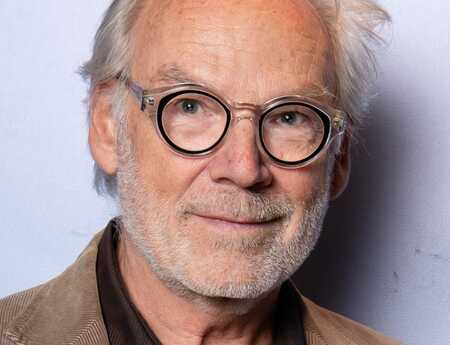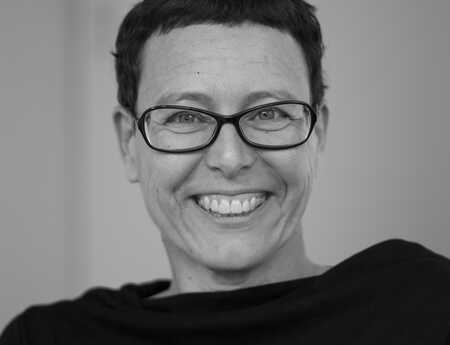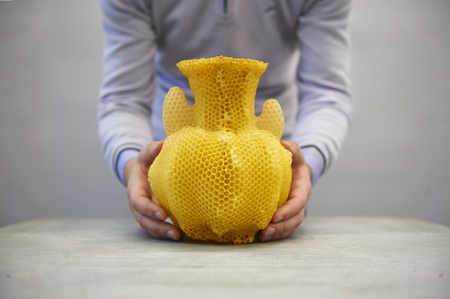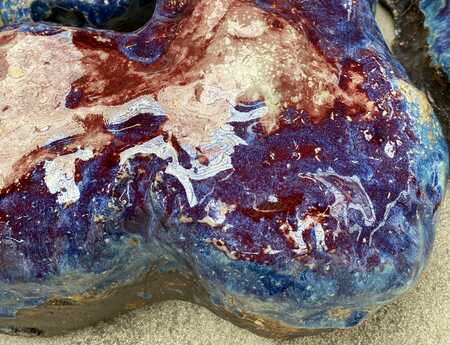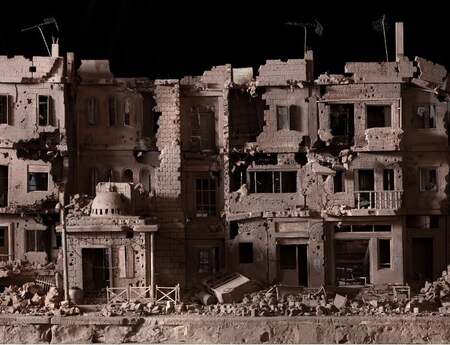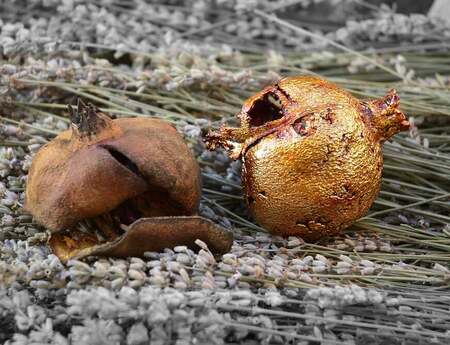Tomáš Gabzdil Libertíny: Co-creating with Bees
Artists are masters at visualizing, imagining, and persuading. With their work, they tell stories that make a lasting impression. When it comes to climate, their approach is not necessarily scientific; sometimes their work stems from an interest in the beauty and intelligence of nature.
For Tomas Libertíny (Slovakia, 1979), the relationship between man and nature is a constant source of inspiration. With his work, he shows that we are part of nature. By studying nature carefully and adapting our behavior, our consumption, we can contribute to the survival of our planet.
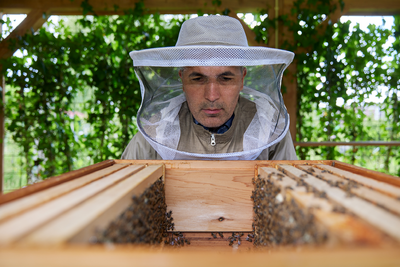
We meet at Libertíny's bee farm on the grounds of Villa Lakeside, which houses the company of investor and art collector Ali Keles. Together with Keles, Libertíny set up his bee farm three years ago. Five hives are neatly grouped under a canopy at the water's edge. That is where the collaboration between the artist and the bees takes place; the bees complete the shapes Libertíny has placed in the hives. This cooperation produces intriguing objects that were presented in the new section ‘Artistic Matters’ at the edition of Art Rotterdam 2024 and were very recently seen in the Israel Museum in Jerusalem.
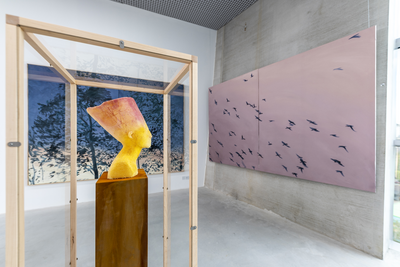
Tell me about these hives; how do they function?
“We have five hives. At the beginning of spring, they are quite active. In the biggest one, the bees are invited to work on the structures that I have placed within. I have developed a system where I can check the progress without opening the beehive. There are viewing windows with glass that allow me to see how the bees are progressing, and in this way, I respect the bees and do not make them too nervous.”
You are not the beekeeper; there is another person who takes care of the bees. Why is that?
“I wanted to separate the beekeeping from the making of the artwork. As an artist, I want to push the limits of the craft. But being nature-friendly and respectful, I didn’t want to cross certain boundaries where my ambition could lead me. So, I take advice from the beekeeper, and he tells me what can be done to maintain the health and quality of the colony. During the last seventeen years, I have been working with beekeepers. But for five years, I have had my own colony here in Rotterdam-Overschie.”
What do you do with the honey that the bees produce?
“We are not really focused on honey, like other beekeepers. We leave most of the honey to the bees, and if there is a surplus, the beekeeper harvests that.”
About ten minutes later, we start walking to the hives, where Libertíny lifts a round panel from the back of a tall hive so we can look inside. We see two shapes, on which the bees are landing and patiently making honeycombs. In the four other hives, there is still little activity to be seen. In them, new queens are being introduced so that they can eventually form a new colony. Bees live about five to six weeks, and the queen lives five to six years.
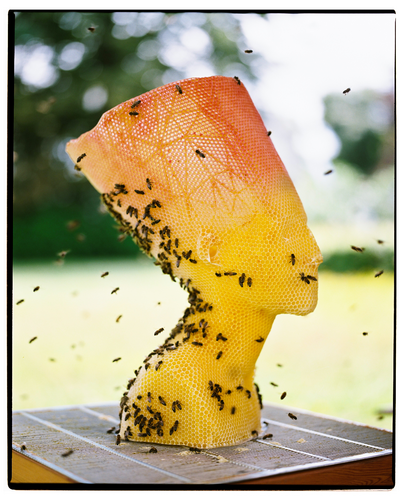
How are the start-up forms made?
“The statue of Nefertiti that I showed this summer in Kunstmuseum Den Haag was a kind of breakthrough. The framework is like a latticework, a scaffolding for the bees to build their skin around, which becomes a honeycomb. I designed it knowing what they liked as a form. They love hanging in the trees and bushes with these intertwined branch structures. It’s exactly like what Nefertiti looks like when it is a naked 3D printed form; I designed it to look like branches of a bush.”
You often use vase forms for your work, but one can also find a lot of historical figures in your oeuvre. Is history taking an important place in the design of your work?
“Definitely. I have great respect for history and mythology. I use it as a source and try to make interpretations from those stories, bring historical figures back to the 21st century, and give them a new meaning. In the Israel Museum, I had an exhibition with the title Crafted by Bees. There, I showed a portrait of Hadrian. In the archaeology department of the museum, there is a huge bronze sculpture of him. In antiquity, bronze sculptures were made with bee’s wax. The wax was melted away, and then they were cast in bronze. So, I did an artistic interpretation with the bees on how the original bronzes looked in wax but were made by bees. I made two versions of Hadrian: one more realistic and one more abstract.”
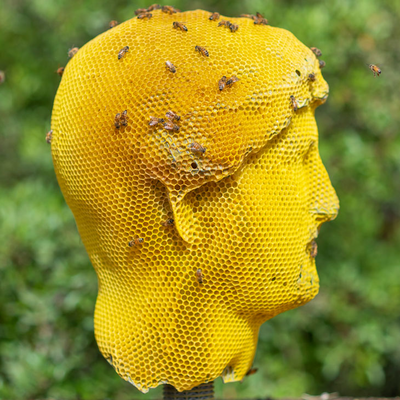
As for the relationship between man and nature that you are mentioning on your website. Do you find it to be a positive relationship?
“Nature is neither good nor bad. We romanticize the fact that we have to be one with nature and criticize ourselves when we act differently. We are just part of nature as an individual organism, like many other organisms and species, without any ground or intention.”
Don’t you think that man has disturbed the balance in nature?
“Of course that is true, but I want to look at it in a positive way. I am inspired by the good and bad things in nature. Besides the fact that we have this incredible negative impact on the earth, we are the only species on the planet that can retroactively repair the damage that we have caused. I have hope that we can turn things for the better.”
Did you notice yourself that the bee populations are decreasing?
“On my bee farm, this usually does not happen because we work with a professional beekeeper. However, sometimes it happens that the colony dies. Out of five, one colony doesn’t survive the winter. But I have heard from other beekeepers that colonies die more and more. It is still not as it is in China. About ten years ago, in a Chinese region, the negative impact of the pollution on the habitat of the bees was so powerful that they lost almost all the bees. So, people had to pollinate their own apple trees manually. It’s an incredible Mad Max scenario.”
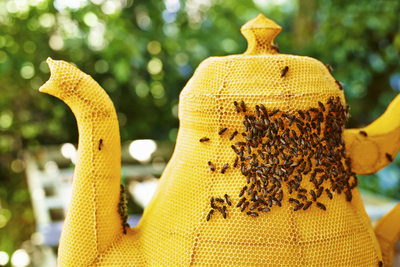
Not only the number of bees but also the total number of insects has seriously decreased. According to a recent study, the number of flying insects has decreased over the last 27 years by as much as 76 percent. Is there anything to do about it?
“Nowadays, there are fewer other insects than bees, but bees are still very popular among humans. But if we talk about pollination, bees are only one little part of it. There are so many other insects that are necessary for other types of plants. And the number of these insects is indeed strongly declining. Because of that, the biodiversity of the flora will probably go down, and the role of the bees will become more important as other insects disappear. One of the solutions would be not to cut the grass in the cities all the time, so certain insects can have a habitat for their reproduction. I am in favor of an organized wilderness in the cities. And of course, we all can do our little part. For example, I myself don’t have a car; when I really need one, I rent it.”
True Colors, AkzoNobel Art Foundation in Kunstmuseum Den Haag
1 June 2024 until 29 September 2024

